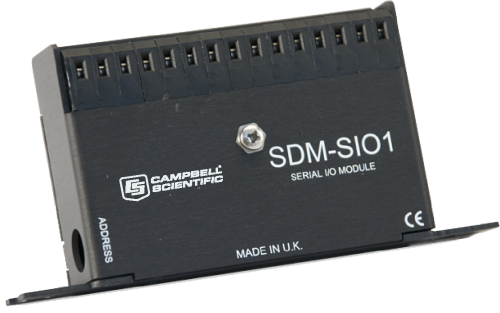This product is not available for new orders. We recommend ordering: SDM-SIO1A.

| Services Available |
|---|
Resumen
The SDM-SIO1 is an RS-232, RS-422, or RS-485 serial expansion module. Up to fifteen SDM-SIO1 modules may be connected to a single data logger SDM interface. This module is commonly used to interface serial sensors to a data logger. Please refer to the Compatibility information regarding which data loggers the SDM-SIO1 may be used with.
Leer másVentajas y características
- Expande el número de dispositivos serie que pueden comunicar con el datalogger
Imágenes

Descripción detallada
The SDM-SIO1 is a serial expansion module that allows a data logger to communicate with serial devices that interface using true RS-232, RS-422, or RS-485 signals. Up to fifteen SDM-SIO1 modules may be connected to a single data logger SDM interface. Remote serial devices use industry standard hardware and protocols to connect to the data logger through the SDM-SIO1 interface. When operating in the RS-232 mode, the module also provides hardware handshaking. The SDM-SIO1 Module is implemented in such a way that it looks like a built-in serial port to the user when writing programs in CRBasic. This means that all the user needs to do is define the address of the SDM-SIO1, using a rotary switch on the side of the unit. The serial port can then be used as if it were built into the data logger.
Productos similares
Preguntas frecuentes
Número de FAQs relacionadas con SDM-SIO1: 9
Expandir todoDesplegar todo
-
The CR5000 does not natively support communication with serial sensors; however, SDM-SIO1 modules can be added to collect data from serial sensors.
-
The SDM-SIO1 has lower power biasing of its inputs and no internal termination resistors, so it operates in the lowest power state. However, this means it can quite easily detect noise on the RS-422 cable, which can, for instance, be picked up from power leads. A simple solution to this is to add 120R termination resistors at one or both ends of the cable. Although termination resistors are only normally needed on long cable runs, they are also quite effective at reducing noise.
-
The SDM-SIO1 acts as a virtual serial terminal to a CRBasic data logger. The data logger’s serial functions can be used to control the device.
-
Yes. This feature was added in 2013. Ensure that both the data logger operating system and the SDM-SIO1 firmware are up to date. Using an SDM-SIO1, the data logger can be a Modbus client or server, although the intended and most common use is for client operation. In CRBasic, use the SerialOpen() instruction to configure the SDM-SIO1 interface and the ModBusClient() instruction to issue Modbus commands.
-
An interface is required. This can be done using an SDM-SIO1, or a third-party RS-422 to RS-232 converter.
-
Use four SDM-SIO1s or a single SDM-SIO4.
-
It depends. It is possible to connect serial sensors to a datalogger without the use of an SDM-SIO4. However, if the sensors require hardware flow control or true RS-232 voltage levels, an SDM-SIO4 may be needed. The SDM-SIO1 also works with RS-485 signals and is a preferred alternative to the SDM-SIO4.
-
The MD485 RS-485 Multidrop Interface is a general communication interface or serial converter. Additionally, the MD485 can be used without a datalogger and offers collision avoidance for PakBus communications.
The SDM-SIO1 Serial Input/Output Module is designed for acquiring data from smart serial sensors, rather than for general communications like data collection or program downloads. The SDM-SIO1 can operate in half- and full-duplex modes, has a smaller form factor, works with RS-422, and can be daisy-chained in quantities of up to 15 on a single three-wire SDM port.
-
The CR1000, CR3000, and CR800-series dataloggers can be used to collect and process binary data from smart sensors via serial or TCP/IP socket connections. In some cases, a converter or communications peripheral may be required.
Note: The capabilities mentioned above are not available for the CR200X-series, CR5000, and CR9000X dataloggers.
Compatibilidad
Nota: lo siguiente muestra información de compatibilidad notable. No es una lista de todos los productos compatibles.
Dataloggers
| Producto | Compatible | Nota |
|---|---|---|
| CR1000 (retired) | ||
| CR200X (retired) | ||
| CR216X (retired) | ||
| CR3000 (retired) | SDMs are connected to the ports labeled SDM-C1, SDM-C2, and SDM-C3. | |
| CR5000 (retired) | The CR5000 operating system must be OS 6 or higher. SDMs are connected to the ports labeled SDM-C1, SDM-C2, and SDM-C3. |
|
| CR6 | ||
| CR800 (retired) | ||
| CR850 (retired) | ||
| CR9000X (retired) | The CR9000X operating system must be OS 6 or higher. |
Información de compatibilidad adicional
Data Logger Considerations
The SDM-SIO1A does NOT support auto baud rate detection nor the use of the serial port for general PakBus communications.
Enclosure Considerations
The SDM-SIO1 requires a desiccated, non-condensing environment. The SDM-SIO1 has built-in keyhole flanges for mounting to the backplates of Campbell Scientific enclosures.
Especificaciones
| Modes of Operation |
|
| Data Rates | 300, 1200, 2400, 4800, 9600, 19200, 38400, 57600, or 115200 bps |
| Data Format |
|
| EMC Compliance | Complies with IEC 61326. |
| Power Supply Connection | +12 V |
| Operating Voltage |
|
| Operating Temperature | -25° to +55°C |
| Dimensions | 5.4 x 8.0 x 2.5 cm (2.2 x 3.1 x 1.0 in.) |
Current Drain |
|
| Standby |
|
| Active | 5 to 13 mA (depending on transmit mode and connections made) |
Buffer |
|
| Storage Type | Both transmit and receive buffers are fill and discard. |
| Transmit-Buffer Size | 767 bytes (buffer from data logger to sensor) |
| Receive-Buffer Size | 2047 bytes (buffer from sensor to data logger) |
